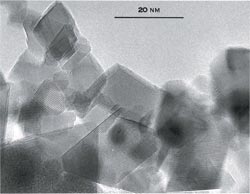A new plasma arc particle production process helps meet stringent requirements.
Dr. Patrick G. Murray, Nanophase Technologies Corp.
Performance improvements are increasingly being sought in a variety of technologically advanced polishing applications related to the optics and microelectronics industries. From the production of photomask blanks to the fabrication of memory and process devices, better surface roughness coupled with reduced defectivity is critical to achieving the requirements of future technology nodes. Cerium oxide (ceria) is widely used in glass and silicon oxide polishing operations because of its unique ability to polish both chemically and mechanically.
The polishing of glass using ceria particles, despite being well-established and benefiting from a relatively long history of use, is still rather poorly understood from a fundamental, mechanistic standpoint. As a result, the development of new polishing processes often remains empirical in practice. The reasons why extrapolation from theory to practice is difficult are myriad and include the enormous number of glass compositions available, the unique chemical attributes associated with different particles, the considerable influence of the pad or pitch system, and the almost unlimited combinations of process conditions and operating parameters.
Nevertheless, whether from theoretical considerations or from experimentally derived observations, continuous progress toward evermore challenging surface finishes continues to be required for photomask blanks, lithography optics and glass ceramic rigid memory substrates.
As an example, the relationship among the polishing slurry particle size (and particle size distribution), the glass surface finish and the degree of subsurface glass damage (or defects) is fairly well characterized. In many cases, the surface roughness and defectivity requirements are becoming sufficiently difficult to achieve that the particle size must routinely be in the nanometer range for the final finish-polishing step.
Until recently, producing such particles meant mechanically reducing their size (milling), burning an organometallic precursor in a controlled fashion to generate particles (fumed) or creating insoluble particles from ionic solutions (precipitation). However, as particle sizes get smaller, a more demanding set of requirements emerges from the perspective of providing a stable, high-performance precision polishing slurry:
• The particles must be dispersed down to their primary size. Although this seems obvious, particles produced by a fumed process often exist as higher-order, durable agglomerates, while those produced by a milling operation may not have a sufficiently high zeta potential to maintain a concentrated, stable dispersion of primary particles.
• The dispersion of particles must remain stable. As the surface area of the particles increases, this becomes a nontrivial problem, particularly as the slurry is subjected to the polishing environment and encounters high ionic strength.
• The particles should be nonfriable. Highly porous or highly amorphous particles can fracture to generate smaller fragments (fines) during a polishing operation, reducing the effectiveness of the abrasive, introducing variability into the polishing operation and potentially creating cleaning problems.
• The particle size distribution must be tightly controlled. The importance of this aspect of slurry design cannot be overemphasized, but it can be challenging to achieve on a commercial scale with acceptable economics.
Recently, a specialized plasma arc process was developed by Nanophase Technologies Corp. of Romeoville, Ill., to manufacture nanocrystalline cerium oxide with high chemical purity and tightly controlled particle size. This process produces nanometer-size particles that are discrete single crystals (see figure). The nanocrystalline ceria is nonporous and near theoretical density, which means that the particles do not change size, shape or density during a polishing operation.

A transmission electron micrograph shows the discrete nanocrystalline cerium-oxide particles.
Moreover, the “active plasma” technology enables the surfaces to be engineered to have high zeta potentials when the particles are dispersed in water. This ensures that the particles can be efficiently dispersed down to individual primary crystallites and that the dispersion will remain stable because of the high degree of electrostatic repulsion created between particles.
Finally, once a stable, low-viscosity dispersion is obtained, the truncation of the particle size distribution to a polishing performance specification can be accomplished, and useful process additives such as lubricants, dispersants and pH buffers may be added.
The small particle size, tightly controlled particle size distribution and unique crystal morphology of these nanoengineered materials are allowing new performance benchmarks to be realized in the planarization of silicon wafers and the polishing of photomask blanks, lithography optics and rigid memory substrates.
Meet the author
Patrick G. Murray is a senior applications scientist at Nanophase Technologies Corp. in Romeoville, Ill.; e-mail: [email protected].